Under unimaginable conditions, local organisations continue to deliver life-saving services in Gaza. With support from Dutch private donor funding, Cordaid enables partners on the ground to provide mine awareness education to thousands. And to give prosthetic care to 140 individuals who suffered limb loss.
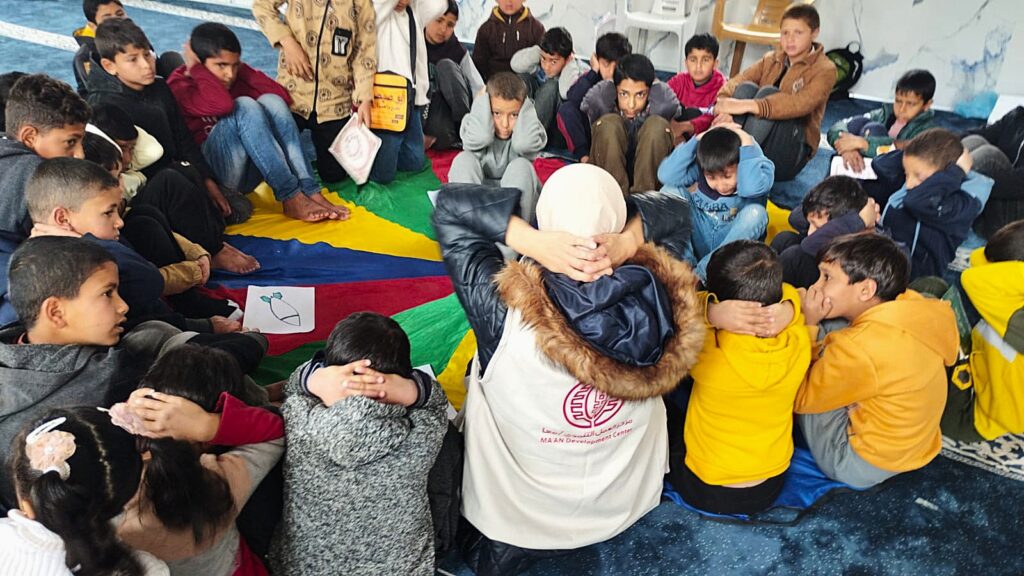
In the sealed-off warzone of Gaza, local humanitarian workers achieve the seemingly impossible. They save lives and deliver emergency aid despite constant danger. After eighteen months of relentless bombardment and the killing of more than 400 aid workers, their organisations remain steadfast and operational. Cordaid supports two of them.
Thanks to this support, Ma’an Development Centre, in collaboration with Danish Church Aid (DCA) and Norwegian Church Aid (NCA), has provided Explosive Ordnance Risk Education (EORE) and Conflict Preparedness and Protection (CPP) sessions to over 40,000 children and adults. It also helps Caritas Jerusalem, in partnership with the Artificial Limbs and Polio Centre in Gaza, deliver prosthetic services to limb loss survivors.
Beyond these essential interventions, Ma’an Development Centre, Caritas Jerusalem, and Danish Church Aid implement a wide range of other humanitarian programmes in Gaza and other parts of Palestine.
Unprecedented Scale of Destruction
An estimated 100,000 tonnes of explosives have been dropped on Gaza since October 2023. The Lancet concluded that official figures significantly under-report mortality, estimating 64,260 deaths from traumatic injury up to 30 June 2024, and when extended to October 2024, likely exceeding 70,000. Most of them were women, children, and elderly people. Over 90% of residential houses and buildings, including hospitals and schools, have been destroyed or damaged. More than 90% of Gaza’s 2 million residents have been displaced multiple times.
The sheer scale of destruction is unprecedented.
The humanitarian crisis worsens by the hour. Anton Asfar, Secretary-General of Caritas Jerusalem, reports: ‘Since March 2nd, all borders are closed, including those for humanitarian assistance. Meanwhile, two million people are on the brink of starvation. Fuel, food, and medical supplies run dangerously low, threatening essential services, including the few remaining operational hospitals. All bakeries have shut down. Food insecurity is at its worst. The blockade not only prevents aid from entering. It also devastates the private sector, driving up prices of what little remains to unimaginable levels.’
Killed Inside a Church
As a Jerusalemite, Asfar is not allowed to enter Gaza. However, he and his Caritas team remain in daily contact with the 102 Caritas staff inside Gaza. ‘We do what we can to support and protect our humanitarian staff. But the truth is that I often feel powerless and paralysed,’ he admits. ‘We constantly monitor the security situation, but unfortunately, humanitarian notification systems in Gaza are ineffective. So far, 408 aid workers in Gaza have been killed. Among them was Viola. She was one of our health workers. Together with her family, she was killed by an airstrike while seeking shelter inside a church. And the violence just doesn’t stop.’
Since the collapse of the ceasefire, on March 18, over one thousand people in Gaza have been killed. On March 23, attacks by the Israeli army on a medical and emergency convoy resulted in the killing of 15 medical and humanitarian workers in Rafah. ‘Due to these horrific attacks, and the bombing of a nearby clinic, we had to suspend operations of one of our medical points’, Anton adds.
Raising Awareness to Save Lives: Explosive Ordnance Education
With a generally accepted 10% failure rate for explosives, another pressing issue is the widespread danger posed by unexploded ordnance. Unexploded remnants of war range from air-dropped bombs to bullets and mortars. They pose an immense risk to civilians, particularly to children, who often mistake them for toys, and adults searching for missing relatives or belongings amid the rubble.
‘They need to be given the means to do more. Because in Gaza everyone, everyday, is at risk of losing an eye, a limb or life.’
‘Water, sanitation, healthcare, and cash assistance are at the forefront of international humanitarian action for Gaza. They are also part of Cordaid’s support. However, mine action and prosthetic interventions remain grossly overlooked, despite the huge need for these services,’ remarks Cordaid humanitarian coordinator Laurens Den Dulk.
To address the deadly risks of explosive remnants of war, teams from Ma’an Development Center, assisted by DCA/NCA, provide extensive awareness raising.
In the past 1,5 years, Ma’an and DCA’s Explosive Ordnance Risk Education (EORE) and Conflict Preparedness and Protection (CPP) sessions have reached over 40,000 people in Gaza. These sessions equip Gazans with essential knowledge to recognise, avoid, and report explosive hazards.
Ahmad Al Natour from Ma’an explains: ‘We tailor our sessions to different age groups—children, teenagers, and adults. For children, we use games, drawing exercises, and role-plays to teach them how to identify dangerous objects and respond safely. For adults, many of whom are searching for relatives or items in their destroyed homes, the training focuses on recognising and reporting suspicious objects. We use real-life simulations to help them prepare for dangerous situations.’
Daily Disruption of Plans
‘We teach participants to recognise unexploded devices, where they are commonly found, such as in rubble or playgrounds, and the importance of not touching them. We instruct children to report suspicious items to their parents or shelter coordinators. They can then inform the police,’ Ahmad adds.
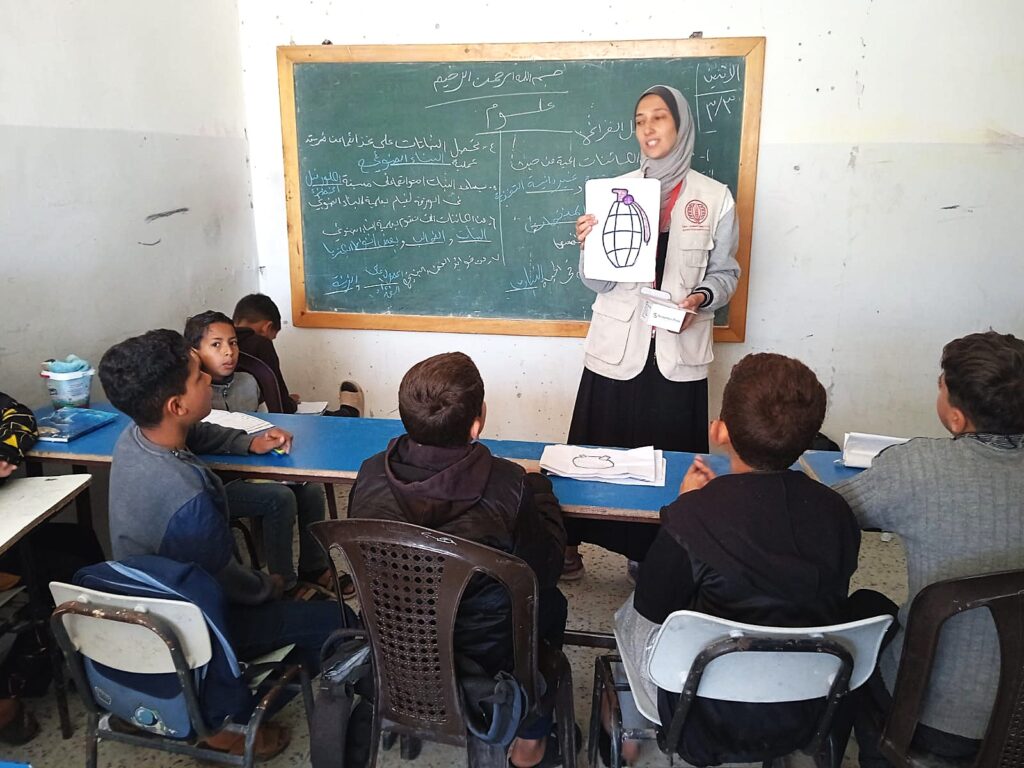
Like everyone in Gaza, Ma’an’s aid workers must constantly adapt their interventions to ever-changing evacuation orders and new emergencies. ‘We mostly work in shelters, often school buildings, or in tents in refugee camps. Sometimes, we operate in markets as far from war zones as possible. But the war disrupts all plans, sometimes daily,’ Ahmad says further.
The Impossibility to Dispose of War Remnants
The removal and disposal of explosive ordnances, a crucial part of mine action, is currently impossible in Gaza, explains Noe Falk Nielsen, a DCA mine action expert. ‘The Israeli Defense Forces have made it impossible to engage in explosive ordnance disposal, or EOD. We can carry out explosive hazard assessments and awareness-raising activities. When unexploded devices are found, people can mark them and warn others. But there is no way they can remove or even touch them. This can only be done by highly skilled EOD experts with the proper equipment and in a secure environment. None of which exist in Gaza.’
As a result, raising awareness and teaching safety measures becomes even more critical.
Ma’an has a team of 10 EORE/CPP facilitators and two master trainers. In 2024 alone, they gave mine awareness education to over 30.000 children and adults in Gaza. ‘Ma’an’s teams are doing an incredible job,’ says Noe, who visited Gaza and worked with Ma’an for over two weeks in January and February. ‘These aid workers need to be given the means to do more. Because in Gaza everyone, every day, is at risk of losing an eye, a limb, or life. This is why it is so important to help Ma’an expand its vital and courageous work.’
Working with Traumatised Communities
Working with deeply traumatised communities, especially in Gaza, where no one remains unscathed, requires the utmost caution and sensitivity.
‘Our teaching materials for children contain drawings and illustrations of explosive devices. Real images could be far too traumatic. And of course, we do not use defused explosive devices for educational purposes. We’re not permitted. It goes against basic EORE principles, and would terrify participants,’ Ahmad points out.
‘Fortunately, the Artificial Limbs and Polio Centre is still operational. They are a lifeline for amputees.’
Ma’an ensures that their EORE facilitators work alongside trained master trainers to deliver sessions effectively, even in overcrowded shelters. The programme continues to evolve. It integrates new materials such as DIY projectors. And it creates engaging ways to raise awareness in the context of the ongoing humanitarian crisis.
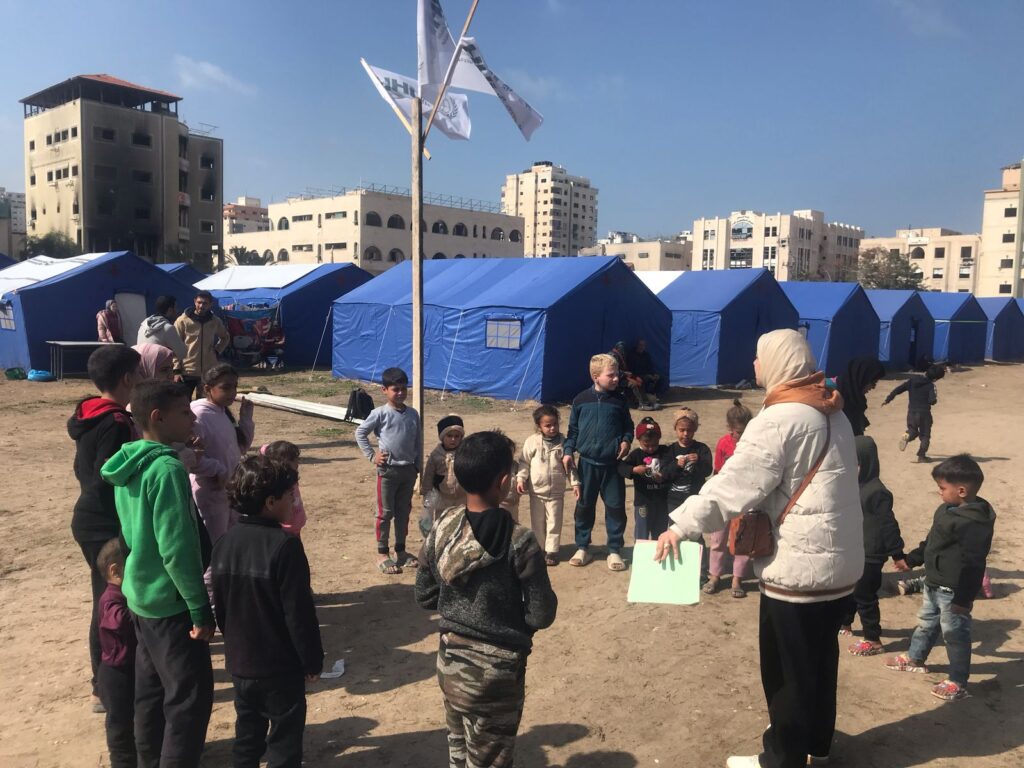
During his stay in Gaza, Noe Falk Nielsen’s admiration for Ma’an’s teams in Gaza has only deepened. ‘They are delivering under huge pressure and facing overwhelming challenges’, he says. ‘I have worked in mine action in multiple warzones over the past two decades. I have never witnessed destruction on the scale I saw in Gaza.’
Life-Saving Prosthetics for Limb Loss Survivors
Alongside these awareness-raising activities, Cordaid is also supporting Caritas Jerusalem in providing prosthetics to individuals who have suffered traumatic injuries. Among the more than 113,000 injured, many have lost limbs while going about their daily lives. Many are children.
The need for prosthetics surges. But the destruction of medical facilities and the humanitarian blockade severely hinder prosthetic supplies and services. ‘Fortunately, our partner, the Artificial Limbs and Polio Centre in Gaza, is still operational. They manage to produce prosthetics and provide rehabilitation services despite the challenging warzone conditions. The centre is a lifeline for amputees,’ explains Caritas Jerusalem’s Secretary-General, Anton Asfar.
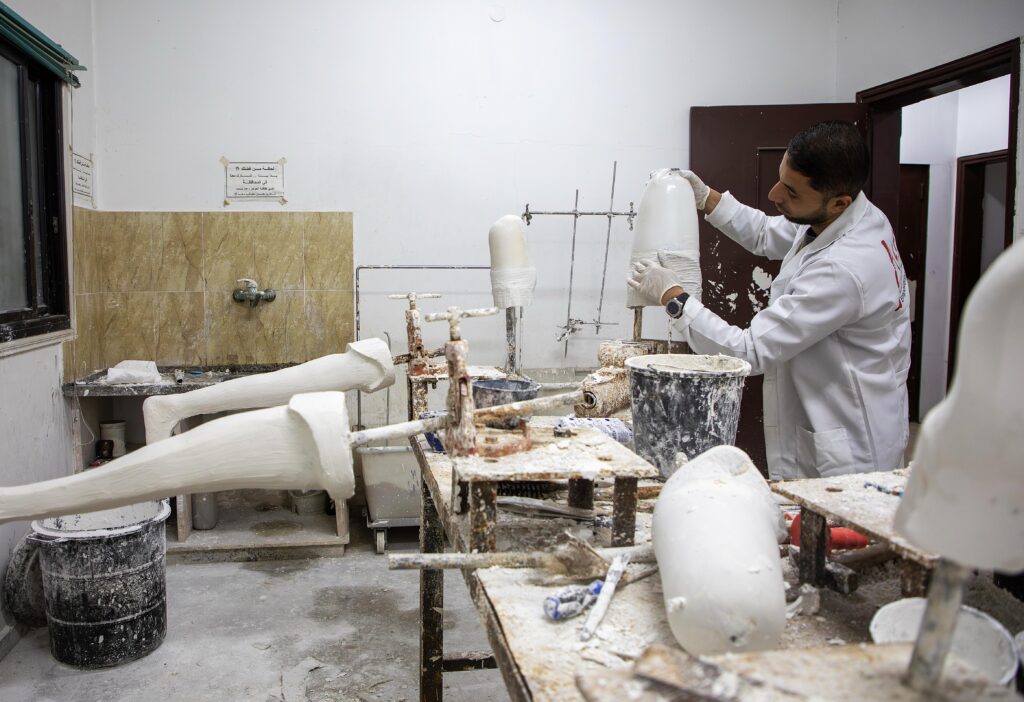
All prosthetic interventions follow a comprehensive approach to ensure each amputee receives a functional, comfortable, and durable prosthetic. The process includes initial consultations, pre-prosthetic training, mould creation, socket fitting, prosthetic assembly, training, follow-up, and regular check-ups.
‘With the resources we currently have, we can support 140 amputees, including children and elderly people. Our intervention goes beyond physical rehabilitation, it also includes financial assistance, psychosocial care, and educational support. People who have lost a limb feel more than disabled. They feel worthless, believing they can no longer provide for their loved ones. We offer comprehensive support, helping them regain their dignity and independence,’ says Anton Asfar.
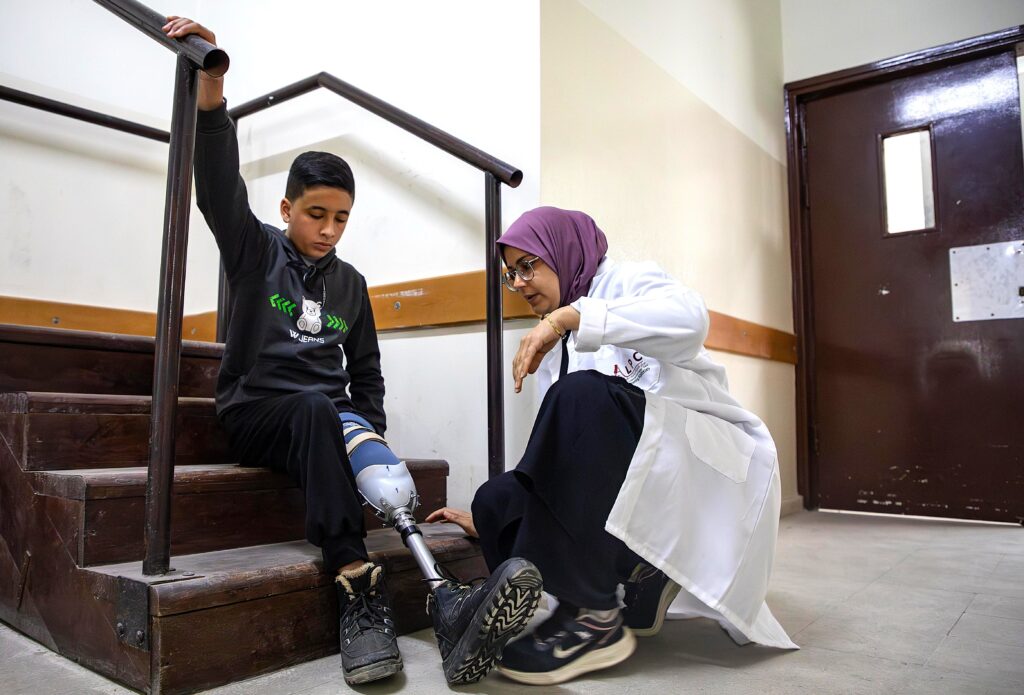
Unwavering Commitment to Serve Others
During the brief window of the now-collapsed ceasefire, aid workers in Gaza had a moment to breathe. But instead of taking time to recover, they redoubled their efforts. ‘I told our staff in Gaza to take some time off, but they wouldn’t hear of it. ‘We will keep serving our people and reduce the suffering,’ they said,’ shares Asfar.
Aid workers in Gaza risk their lives daily to save others. In the epicentre of devastation, they remain unwavering in their commitment to assisting those in desperate need. As international aid agencies increasingly withdraw due to security concerns and access restrictions, the dedication of local humanitarian staff becomes even more critical. It only highlights the immense responsibility they shoulder.
The Impact of Humanitarian Collaboration
By channelling Dutch SHO/Giro555 support, Cordaid has helped ensure that resources reach local organisations in Gaza. They have the deepest understanding of the urgent needs and daunting realities on the ground.
This collaboration by Cordaid, Caritas Jerusalem, Ma’an Development Centre, and DCA/NCA, made possible by the generosity of Giro555 Dutch private donor funding, shows how international aid, when grounded in local knowledge and partnerships, can make a difference.
Together, we uphold human dignity in the face of ongoing, genocidal violence and suffering.